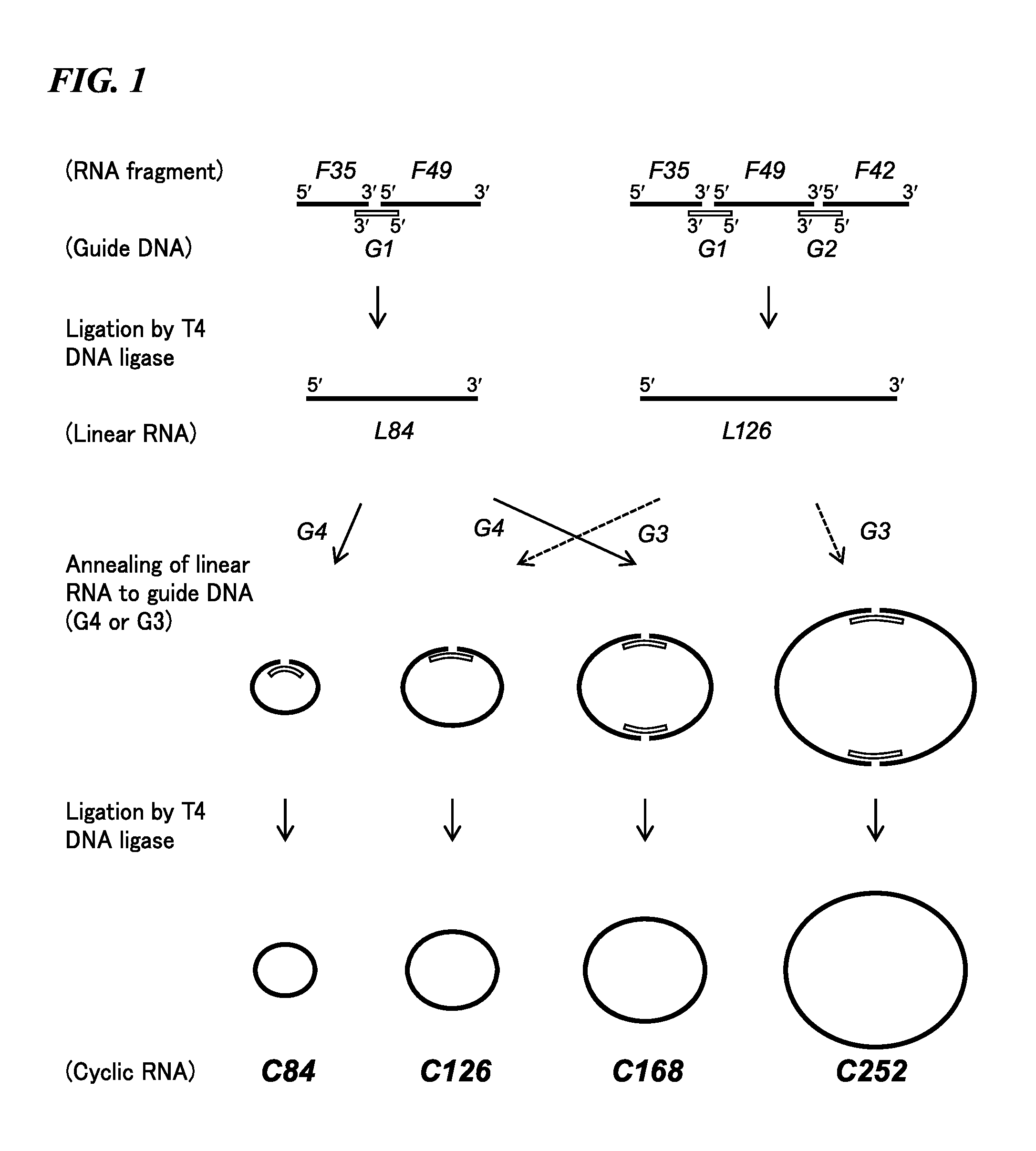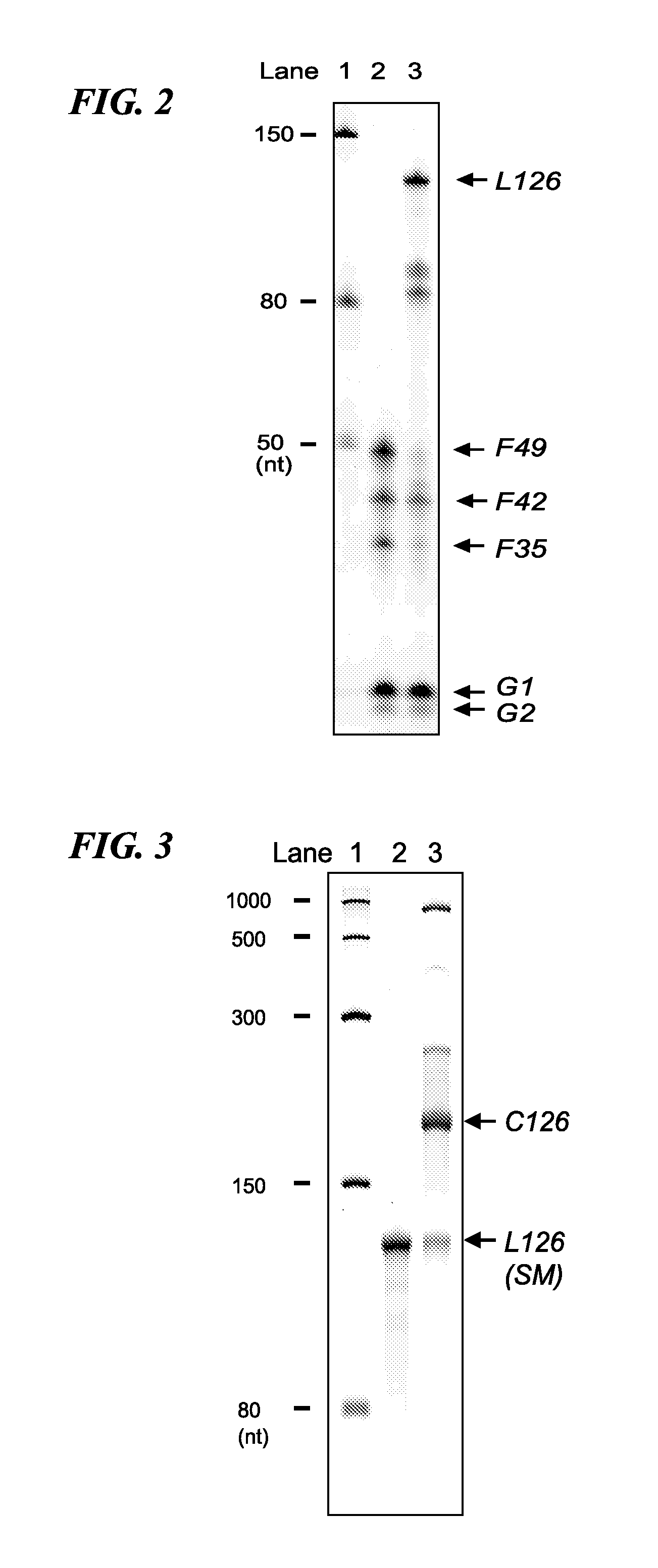Cyclic RNA and protein production method
a cyclic rna and protein technology, applied in the field of cyclic rna and protein production methods, can solve problems such as the rate-limiting step of protein synthesis
- Summary
- Abstract
- Description
- Claims
- Application Information
AI Technical Summary
Benefits of technology
Problems solved by technology
Method used
Image
Examples
example 1
[0070]Cyclic RNA for prokaryotic cells was synthesized having a domain encoding one or a plurality of FLAG peptides, and protein was synthesized in a cell-free system using these cyclic RNA as templates.
[0071]
[0072](1) Preparation of Oligonucleotides
[0073]More specifically, four types of cyclic RNA or linear RNA fragments in the form of RNA oligonucleotides (F35, F49, F42 and F42′) and five types of DNA oligonucleotides used as templates for a ligation reaction using the enzyme T4 DNA ligase (G1, G2, G3, G3′ and G4′) were respectively chemically synthesized. Furthermore, F42′ has a base length of 48 and was obtained by adding UAAUAA to the 3′-terminal of F42. The sequence of each oligonucleotide is shown in Table 1 and SEQ ID NO: 1 to 9 of the sequence listings. In Table 1, the enclosed portion represents the ribosome binding sequence, bases indicated in bold letters (AUG) represent the start codon, underlined locations represent FLAG-encoding sequences, and the double underlined po...
example 2
[0095]Cyclic RNA for eukaryotic cells was synthesized having a domain that encodes a plurality of FLAG peptides, and protein was synthesized in a cell-free system derived from rabbits using these cyclic RNA as templates.
[0096]
[0097]Cyclic RNA for eukaryotic cells was synthesized by a transcription reaction using polymerase. First, DNA oligonucleotides were synthesized using a DNA synthesizer (Fragments 1 to 3 in Table 3, and the sequences thereof are shown in SEQ ID NO: 15 to 17), and after ligating with T4 DNA ligase, double-stranded DNA oligonucleotides having 155, 284, 290 and 413 base pairs (template DNA) were synthesized by annealing or PCR (Tables 4 and 5). Next, in vitro transcription was carried out with RNA polymerase using the double-stranded DNA oligonucleotides as templates to synthesize linear single-stranded RNA composed of 129, 258, 264 and 387 bases (Tables 6 and 7), followed by ligating the 5′-terminal and 3′-terminal using T4 RNA ligase to synthesize cyclic RNA. Th...
example 3
[0121]Protein was synthesized in a human-derived cell-free system using the RNA cyclization products synthesized in Example 2 and linear transcribed RNA prior to cyclization as templates.
[0122]Translation reactions were carried out according to the product manual using the AvidExpress™ Cell-Free Translation System (derived from human HeLaS3 cells, Avidity Inc.) to a final RNA template concentration of 1.2 μM. Following completion of the reactions, 2.5 μL aliquots were sampled from each reaction liquid and electrophoresed using 10% to 20% gradient polyacrylamide gel in the same manner as Example 2, and after transferring the protein that developed in the gel to a PVDF membrane, the protein was reacted with anti-FLAG antibody and anti-mouse IgG antibody-HRP complex followed by reacting with HRP substrate to visualize protein bands specific to the FLAG sequence.
[0123]FIG. 15 shows the results of visualizing protein bands containing FLAG. In FIG. 15, RNA-free reaction liquid was applied...
PUM
| Property | Measurement | Unit |
|---|---|---|
| Length | aaaaa | aaaaa |
Abstract
Description
Claims
Application Information
 Login to View More
Login to View More - R&D
- Intellectual Property
- Life Sciences
- Materials
- Tech Scout
- Unparalleled Data Quality
- Higher Quality Content
- 60% Fewer Hallucinations
Browse by: Latest US Patents, China's latest patents, Technical Efficacy Thesaurus, Application Domain, Technology Topic, Popular Technical Reports.
© 2025 PatSnap. All rights reserved.Legal|Privacy policy|Modern Slavery Act Transparency Statement|Sitemap|About US| Contact US: help@patsnap.com



